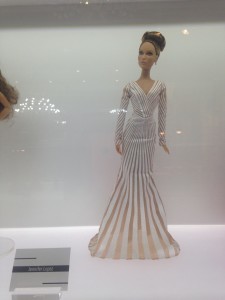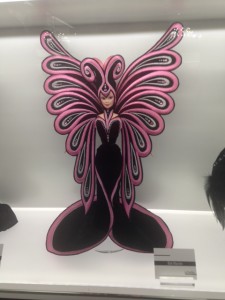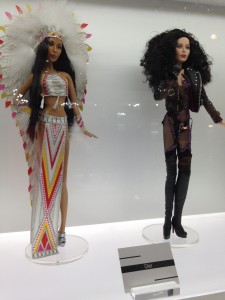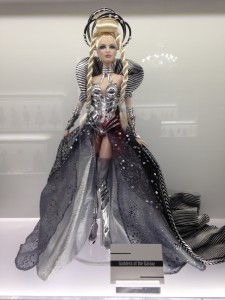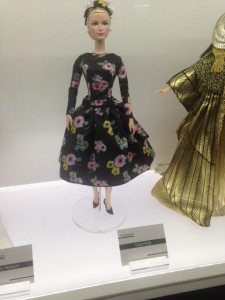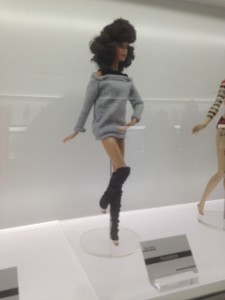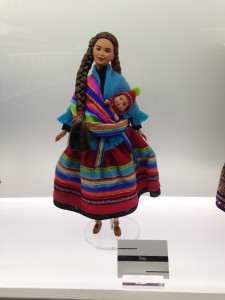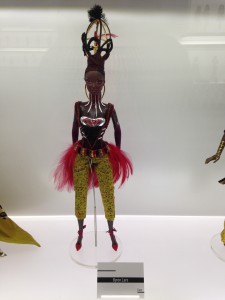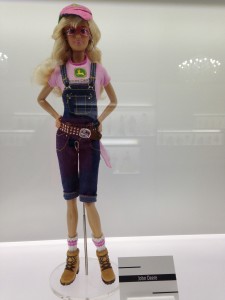*This article was first published on fab feminist site Bust.com
I loved Barbies as a kid. Then as an adult, I learned that the dolls were an embarrassment to humanity. Now, I’m back: I heart Barbie. My change of opinion happened after visiting the new BARBIE EXPO that opened mid-February in downtown Montreal. The must-see exhibit claims to boast the largest permanent collection of Barbie dolls in the world, from JLo and Duchess Kate Barbies, to Chanel and Vera Wang Barbies, to Steampunk Barbie with green hair and a long frightening coiled neck.
After perusing the expo’s mind-boggling array of 1000+ high-fashion Barbie dolls, I was reminded that Barbie is just a fun dress-up toy to inspire the imagination—and is probably not a symbol of all that is evil in this world.
After Hijab Barbie and Mattel’s tall, curvy, and petite Barbies created recent media stirs, now in proper Montreal form, Barbie gets reinvented once again as a cool-girl with a fantastical fashion streak. This depiction manages to transcend Barbie’s locked and loaded reputation as an icon of conformity—a reputation Mattel has long tried to reinvigorate after she was introduced in 1959. But Expo Barbie likely succeeds in transforming her image because the collection was put together by independent curators, and not by Mattel. As such, these dolls don’t look like they’re trying to sell anything—they simply appear as fixtures of private life, and reflections of whoever bothered to collect or design the elaborate outfits in the first place (some garments went through 200 hours of fittings with their designer.).
With Barbie as fashion muse, the exhibit is flying high with entertainment: There are Barbies à la Beyonce, Kimora Lee Simmons, Cher, Farrah Fawcet, Marilyn Monroe, and Princess Grace. There are dolls outfitted by Dior, Armani, Bob Mackie, and Ralph Lauren. Then there are Barbies donning feathers, kimonos, a sari. There are even underground alternatives tattooed Barbies. In terms of diversity, there are Barbies of various races and complexions represented, although the majority of dolls are white, though not necessarily blond. Barbie’s body proportions from head shape to height are even toyed with—though again, she’s almost always skinny, or in the case of Flashdance Barbie, gaspingly thin.
Even with the expo’s all-encompassing lens, the doll still gives off an unrealistic body image.
But overall, the expo creates a more forgiving impression of Barbie, allowing the doll to come across as whimsical and playful—a woman of reinvention like Madonna, or an eccentric style blogger of sorts—rather than a blond blue-eyed bombshell who mothers have come to protest against, not to mention who has attracted a string of tacky plastic-surgery enhanced followers. And like me, you may end up leaving the expo remembering Barbie as that childhood doll you adored because it was simply fun as heck to change her outfits—not because you were somehow brainwashed and misguided by the Dreamhouse fantasy.
The Barbie Expo was put together by the administration of Les Cours Mont-Royal, a shopping mall in downtown Montreal that was once regarded as the city’s mecca of fashion, but now has an unfortunate vacancy rate. Looking to bring-in a high-style attraction, the administrators created a committee of curators, architects, designers to collect the Barbie Expo dolls from around the globe. The team purchased some of the Barbies outright from collectors, while others were donated. The free-of-charge Expo gives 100% of proceeds from the suggested donations to the Make-A-Wish foundation of Quebec.
Many of the Barbies featured were once sold to the public as limited-edition dolls by Mattel. Others were created by artists or private collectors themselves, allowing Barbie to surpass market barriers and enter more expansive spheres, such as the one exhibited by Hijab Barbie (a.k.a. @hijarbie), sewn by 24-year old Haneefa Adam of Nigeria (Hijarbie is not part of the exhibit).
“Pure coincidence,” Valerie Law said of the expo’s timing, which opened on Feb. 10, right on the heels of Barbie’s new silhouettes featured in Time, and moments after Hijab Barbie became an internet darling. Law is the VP of marketing for the Soltron Group that owns Les Cours Mont-Royal. “We brought this exhibition here to Montreal because it is a fashion capital. And no one is really highlighting that about the city.” Law cites the elegant Zuhair Murad Barbie as her favorite.
As Montreal’s Barbie Expo is not affiliated with Mattel, the exhibit is likewise sans bubble gum pink displays. (The much-maligned gender-specific sales presentation found in many toy stores is a stigma Mattel also tried to overcome by featuring a boy in a 2015 commercial.) Rather, at the expo, the backdrop is a fresh white and black, with swirling crystal chandeliers. This more classical, and far less dizzying environment is more suited to dragged-along daddies, brothers, or even not-quite-so girly-girls visiting the expo. Meanwhile, Barbie aficionado’s will have their eyes popping out at every turn. They may even find themselves manically posing in the Barbie selfie booth with #ExpoBarbie. (umm… guilty.)
Heads-up: There are no actual Barbies for sale at this independent charity exhibit. Also, curvy, tall, and petite Barbies and Hijarbie have yet to make their debuts at the Barbie Expo.
Once upon a time, while at The New School, Suzanne Wexler wrote her M.A. thesis on “The Erosion of Public Discourse: The Martha Stewart Trial and Other Provocative Tales.” It was supervised by the late and great Christopher Hitchens, along with linguist Melissa Monroe. After moving back to Montreal, she wrote feature articles and trend reports for major Canadian newspapers. She also got married and had some super-cute kids. Now she’s working on a book of humor essays. Find her at www.suzannewexler.com.
